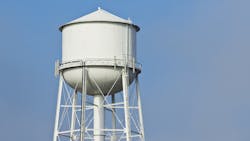What Is The Purpose Of Water Towers?
Most people who live in suburbs are used to consistent, reliable water pressure. This is largely thanks to water towers.
This article will discuss the uses and purpose of water towers, as well as how they’re built and how they work.
What Is A Water Tower?
A water tower is a tall structure that holds a pressurized potable water system.
Most water towers store potable (drinkable) water and operate in conjunction with drinking water reservoirs.
Steel and concrete are two popular materials used in the construction of a water tower. Water towers have an interior coating to protect the water from contaminants in the outside materials. Most water towers are about 130 to 165 feet tall.
Water towers are located on high ground to provide enough pressure to send water into a municipal water supply with enough force to supply all the customers in the area. A water pressure of about 0.43 PSI (pounds per square inch) is provided by every foot of height in a water tower.
A water tower’s tank is large, holding 1,000,000 gallons of water or more. Most water towers are sized to be able to hold up to one day’s worth of water for the community they serve.
What Are Water Towers Used For?
Water towers are used to store and deliver pressurized water to a community:
- First, water is sourced (usually from a reservoir, river, or well) and treated by a water treatment plant to remove suspended sediment, microorganisms, and other pollutants.
- In most towns, the water is then pressurized by a high-lift pump and sent to the community in primary feeder pipes.
- If more water is produced than is needed, the leftover water will be sent into the water tower. Then, in times of peak demand, water can be supplied from the tower to supplement the water being produced instantly by the treatment plant.
Without a water tower, there wouldn’t be enough pressure to send water through the distribution pipes at a fast enough rate. Water towers use gravity-driven hydrostatic pressure, which forces water at speed through the system.
The majority of people on a city water supply will have never experienced reduced or no water pressure after switching on a faucet. That’s thanks to water towers, which almost guarantee a stable, adequate supply of water for all household uses.
Water towers can even work for a limited time without electricity because they just need gravity to send water through the distribution pipes. Electricity is eventually needed, however, because the pump used to refill the tower is usually electric.
A water tower is designed to minimize costs associated with water distribution, for two reasons:
- Water towers reduce the quantity of pumping stations required in the region and allow for the centralization of pressurization and pumping
- Water can be pumped up to the tower during off-peak times of the day, which reduces costs linked to running the pumps
Pros & Cons of Water Towers
Pros
- Water towers make it easy to maintain consistent pressure in a public water system, which is normally very difficult.
- Water towers provide a good reserve of water to cope with times of peak demand.
- As long as the water tower is elevated enough, it should effectively distribute water with hydrostatic pressure, driven by gravity, alone.
- Installing a water tower means that money doesn’t have to be spent on a water pumping system that’s powerful enough to keep up with peak demand.
Cons
- Even the best water tower can’t prevent a slight drop in water pressure during surges in demand.
- Water can only flow to areas of lower elevation than the starting point (the water tower), so it may be limited in hilly regions.
- Water towers may affect the taste and smell of water, especially in the initial few months after installation.
- Untreated water towers may collect a layer of bacteria and sludge. They need to be cleaned at least every three to five years.
Alternatives To Water Towers
The most popular, more recently devised alternative to a water tower is a simple pump attached to the top of the water pipes, which increases water pressure.
This straightforward approach is quicker and easier to set up than a water tower, but it comes with a few unique risks. Contaminants may re-enter the water supply if the pumps fail and water pressure is lost.
Due to the potential risks associated with this approach, it’s only used by smaller water utilities serving a smaller population with a much lower water demand.
Final Word
For most communities, water towers are a reliable, consistent method of supplying filtered, potable water at any time.
While water towers need to be maintained and may cause a slight drop in water pressure, they’re cheaper and simpler than water pumping systems, and are a long-term, cost-effective solution in most scenarios.
About the Author: Brian Campbell is the founder of WaterFilterGuru.com, where he blogs about all things water quality. His passion for helping people get access to clean, safe water flows through the expert industry coverage he provides. Follow him on twitter @WF_Guru or contact him by email [email protected].


